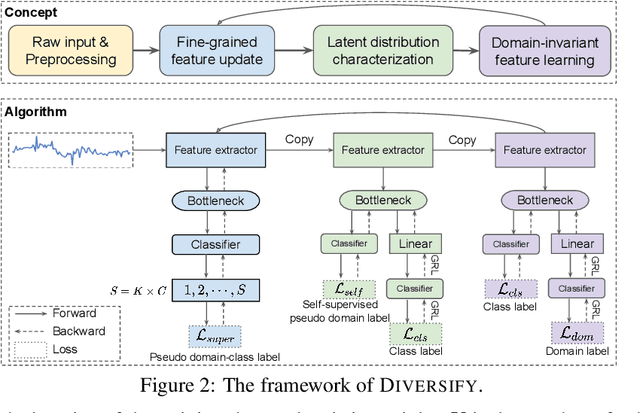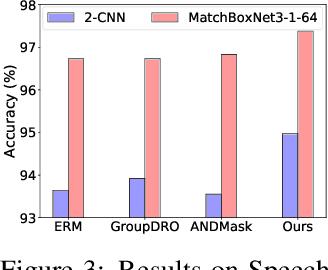Wang Lu
Exploring Scale Shift in Crowd Localization under the Context of Domain Generalization
Oct 22, 2025Abstract:Crowd localization plays a crucial role in visual scene understanding towards predicting each pedestrian location in a crowd, thus being applicable to various downstream tasks. However, existing approaches suffer from significant performance degradation due to discrepancies in head scale distributions (scale shift) between training and testing data, a challenge known as domain generalization (DG). This paper aims to comprehend the nature of scale shift within the context of domain generalization for crowd localization models. To this end, we address four critical questions: (i) How does scale shift influence crowd localization in a DG scenario? (ii) How can we quantify this influence? (iii) What causes this influence? (iv) How to mitigate the influence? Initially, we conduct a systematic examination of how crowd localization performance varies with different levels of scale shift. Then, we establish a benchmark, ScaleBench, and reproduce 20 advanced DG algorithms to quantify the influence. Through extensive experiments, we demonstrate the limitations of existing algorithms and underscore the importance and complexity of scale shift, a topic that remains insufficiently explored. To deepen our understanding, we provide a rigorous theoretical analysis on scale shift. Building on these insights, we further propose an effective algorithm called Causal Feature Decomposition and Anisotropic Processing (Catto) to mitigate the influence of scale shift in DG settings. Later, we also provide extensive analytical experiments, revealing four significant insights for future research. Our results emphasize the importance of this novel and applicable research direction, which we term Scale Shift Domain Generalization.
Harmonizing Intra-coherence and Inter-divergence in Ensemble Attacks for Adversarial Transferability
May 02, 2025Abstract:The development of model ensemble attacks has significantly improved the transferability of adversarial examples, but this progress also poses severe threats to the security of deep neural networks. Existing methods, however, face two critical challenges: insufficient capture of shared gradient directions across models and a lack of adaptive weight allocation mechanisms. To address these issues, we propose a novel method Harmonized Ensemble for Adversarial Transferability (HEAT), which introduces domain generalization into adversarial example generation for the first time. HEAT consists of two key modules: Consensus Gradient Direction Synthesizer, which uses Singular Value Decomposition to synthesize shared gradient directions; and Dual-Harmony Weight Orchestrator which dynamically balances intra-domain coherence, stabilizing gradients within individual models, and inter-domain diversity, enhancing transferability across models. Experimental results demonstrate that HEAT significantly outperforms existing methods across various datasets and settings, offering a new perspective and direction for adversarial attack research.
FHBench: Towards Efficient and Personalized Federated Learning for Multimodal Healthcare
Apr 15, 2025



Abstract:Federated Learning (FL) has emerged as an effective solution for multi-institutional collaborations without sharing patient data, offering a range of methods tailored for diverse applications. However, real-world medical datasets are often multimodal, and computational resources are limited, posing significant challenges for existing FL approaches. Recognizing these limitations, we developed the Federated Healthcare Benchmark(FHBench), a benchmark specifically designed from datasets derived from real-world healthcare applications. FHBench encompasses critical diagnostic tasks across domains such as the nervous, cardiovascular, and respiratory systems and general pathology, providing comprehensive support for multimodal healthcare evaluations and filling a significant gap in existing benchmarks. Building on FHBench, we introduced Efficient Personalized Federated Learning with Adaptive LoRA(EPFL), a personalized FL framework that demonstrates superior efficiency and effectiveness across various healthcare modalities. Our results highlight the robustness of FHBench as a benchmarking tool and the potential of EPFL as an innovative approach to advancing healthcare-focused FL, addressing key limitations of existing methods.
A Language Anchor-Guided Method for Robust Noisy Domain Generalization
Mar 21, 2025Abstract:Real-world machine learning applications often struggle with two major challenges: distribution shift and label noise. Models tend to overfit by focusing on redundant and uninformative features in the training data, which makes it hard for them to generalize to the target domain. Noisy data worsens this problem by causing further overfitting to the noise, meaning that existing methods often fail to tell the difference between true, invariant features and misleading, spurious ones. To tackle these issues, we introduce Anchor Alignment and Adaptive Weighting (A3W). This new algorithm uses sample reweighting guided by natural language processing (NLP) anchors to extract more representative features. In simple terms, A3W leverages semantic representations from natural language models as a source of domain-invariant prior knowledge. Additionally, it employs a weighted loss function that adjusts each sample's contribution based on its similarity to the corresponding NLP anchor. This adjustment makes the model more robust to noisy labels. Extensive experiments on standard benchmark datasets show that A3W consistently outperforms state-of-the-art domain generalization methods, offering significant improvements in both accuracy and robustness across different datasets and noise levels.
Survey on Knowledge Distillation for Large Language Models: Methods, Evaluation, and Application
Jul 02, 2024



Abstract:Large Language Models (LLMs) have showcased exceptional capabilities in various domains, attracting significant interest from both academia and industry. Despite their impressive performance, the substantial size and computational demands of LLMs pose considerable challenges for practical deployment, particularly in environments with limited resources. The endeavor to compress language models while maintaining their accuracy has become a focal point of research. Among the various methods, knowledge distillation has emerged as an effective technique to enhance inference speed without greatly compromising performance. This paper presents a thorough survey from three aspects: method, evaluation, and application, exploring knowledge distillation techniques tailored specifically for LLMs. Specifically, we divide the methods into white-box KD and black-box KD to better illustrate their differences. Furthermore, we also explored the evaluation tasks and distillation effects between different distillation methods, and proposed directions for future research. Through in-depth understanding of the latest advancements and practical applications, this survey provides valuable resources for researchers, paving the way for sustained progress in this field.
ZooPFL: Exploring Black-box Foundation Models for Personalized Federated Learning
Oct 08, 2023



Abstract:When personalized federated learning (FL) meets large foundation models, new challenges arise from various limitations in resources. In addition to typical limitations such as data, computation, and communication costs, access to the models is also often limited. This paper endeavors to solve both the challenges of limited resources and personalization. i.e., distribution shifts between clients. To do so, we propose a method named ZOOPFL that uses Zeroth-Order Optimization for Personalized Federated Learning. ZOOPFL avoids direct interference with the foundation models and instead learns to adapt its inputs through zeroth-order optimization. In addition, we employ simple yet effective linear projections to remap its predictions for personalization. To reduce the computation costs and enhance personalization, we propose input surgery to incorporate an auto-encoder with low-dimensional and client-specific embeddings. We provide theoretical support for ZOOPFL to analyze its convergence. Extensive empirical experiments on computer vision and natural language processing tasks using popular foundation models demonstrate its effectiveness for FL on black-box foundation models.
DIVERSIFY: A General Framework for Time Series Out-of-distribution Detection and Generalization
Aug 04, 2023



Abstract:Time series remains one of the most challenging modalities in machine learning research. The out-of-distribution (OOD) detection and generalization on time series tend to suffer due to its non-stationary property, i.e., the distribution changes over time. The dynamic distributions inside time series pose great challenges to existing algorithms to identify invariant distributions since they mainly focus on the scenario where the domain information is given as prior knowledge. In this paper, we attempt to exploit subdomains within a whole dataset to counteract issues induced by non-stationary for generalized representation learning. We propose DIVERSIFY, a general framework, for OOD detection and generalization on dynamic distributions of time series. DIVERSIFY takes an iterative process: it first obtains the "worst-case" latent distribution scenario via adversarial training, then reduces the gap between these latent distributions. We implement DIVERSIFY via combining existing OOD detection methods according to either extracted features or outputs of models for detection while we also directly utilize outputs for classification. In addition, theoretical insights illustrate that DIVERSIFY is theoretically supported. Extensive experiments are conducted on seven datasets with different OOD settings across gesture recognition, speech commands recognition, wearable stress and affect detection, and sensor-based human activity recognition. Qualitative and quantitative results demonstrate that DIVERSIFY learns more generalized features and significantly outperforms other baselines.
FedCLIP: Fast Generalization and Personalization for CLIP in Federated Learning
Feb 27, 2023



Abstract:Federated learning (FL) has emerged as a new paradigm for privacy-preserving computation in recent years. Unfortunately, FL faces two critical challenges that hinder its actual performance: data distribution heterogeneity and high resource costs brought by large foundation models. Specifically, the non-IID data in different clients make existing FL algorithms hard to converge while the high resource costs, including computational and communication costs that increase the deployment difficulty in real-world scenarios. In this paper, we propose an effective yet simple method, named FedCLIP, to achieve fast generalization and personalization for CLIP in federated learning. Concretely, we design an attention-based adapter for the large model, CLIP, and the rest operations merely depend on adapters. Lightweight adapters can make the most use of pretrained model information and ensure models be adaptive for clients in specific tasks. Simultaneously, small-scale operations can mitigate the computational burden and communication burden caused by large models. Extensive experiments are conducted on three datasets with distribution shifts. Qualitative and quantitative results demonstrate that FedCLIP significantly outperforms other baselines (9% overall improvements on PACS) and effectively reduces computational and communication costs (283x faster than FedAVG). Our code will be available at: https://github.com/microsoft/PersonalizedFL.
FIXED: Frustratingly Easy Domain Generalization with Mixup
Nov 07, 2022Abstract:Domain generalization (DG) aims to learn a generalizable model from multiple training domains such that it can perform well on unseen target domains. A popular strategy is to augment training data to benefit generalization through methods such as Mixup~\cite{zhang2018mixup}. While the vanilla Mixup can be directly applied, theoretical and empirical investigations uncover several shortcomings that limit its performance. Firstly, Mixup cannot effectively identify the domain and class information that can be used for learning invariant representations. Secondly, Mixup may introduce synthetic noisy data points via random interpolation, which lowers its discrimination capability. Based on the analysis, we propose a simple yet effective enhancement for Mixup-based DG, namely domain-invariant Feature mIXup (FIX). It learns domain-invariant representations for Mixup. To further enhance discrimination, we leverage existing techniques to enlarge margins among classes to further propose the domain-invariant Feature MIXup with Enhanced Discrimination (FIXED) approach. We present theoretical insights about guarantees on its effectiveness. Extensive experiments on seven public datasets across two modalities including image classification (Digits-DG, PACS, Office-Home) and time series (DSADS, PAMAP2, UCI-HAR, and USC-HAD) demonstrate that our approach significantly outperforms nine state-of-the-art related methods, beating the best performing baseline by 6.5\% on average in terms of test accuracy.
Out-of-Distribution Representation Learning for Time Series Classification
Sep 26, 2022



Abstract:Time series classification is an important problem in real world. Due to its non-stationary property that the distribution changes over time, it remains challenging to build models for generalization to unseen distributions. In this paper, we propose to view the time series classification problem from the distribution perspective. We argue that the temporal complexity attributes to the unknown latent distributions within. To this end, we propose DIVERSIFY to learn generalized representations for time series classification. DIVERSIFY takes an iterative process: it first obtains the worst-case distribution scenario via adversarial training, then matches the distributions of the obtained sub-domains. We also present some theoretical insights. We conduct experiments on gesture recognition, speech commands recognition, wearable stress and affect detection, and sensor-based human activity recognition with a total of seven datasets in different settings. Results demonstrate that DIVERSIFY significantly outperforms other baselines and effectively characterizes the latent distributions by qualitative and quantitative analysis.
 Add to Chrome
Add to Chrome Add to Firefox
Add to Firefox Add to Edge
Add to Edge